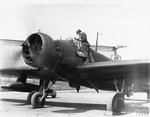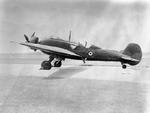Wellesley
| Country | United Kingdom |
| Manufacturer | Vickers-Armstrongs, Limited |
| Primary Role | Light Bomber |
| Maiden Flight | 19 June 1935 |
Contributor: Alan Chanter
ww2dbaseIn many ways the Vickers Wellesley was a quite remarkable bomber which started life as a private venture. Its origin was somewhat unusual, stemming from British Air Ministry Specification G.4/31 to meet a requirement for a general-purpose biplane and torpedo bomber. In 1933, Vickers-Armstrongs built a biplane to this specification which made its maiden flight on 16 August 1934. Simultaneously, Vickers, on its own initiative, designed and built, as a private venture, a monoplane to meet the same specification. This flew on the 19 June 1935 and, when examined by the RAF, comparison of the performance of the two aircraft revealed the Type 246 monoplane to be far superior to the Type 253 biplane. In fact, such were the capabilities of the monoplane that, in September 1935, the Air Ministry was so sufficiently impressed that it replaced the planned order for 150 biplanes by an order for 96 monoplanes written around specification 22/35 and optimised for the medium bomber role with the bomb-load to be carried in two underwing panniers, which thereby simplified construction. These aircraft were given the official name of Wellesley.
ww2dbaseA fabric covered cantilever monoplane with a wing of high aspect ratio, the Wellesley’s most radical feature was the extensive use, for the first time, of the light-alloy geodetic structure devised by Barnes N. Wallis (q.v.), which gave maximum strength for minimum weight. The production Type 287 Wellesley Mk I, which entered service in April 1937, had separate canopies over the twin cockpits, although some later aircraft (unofficially designated Wellesley Mk II) featured a continuous glasshouse canopy bridging the front and rear cockpits. Novel features of these aircraft were the extremely long span wing and underwing bomb panniers which each had a bomb capacity of up to 1,000 lb (454 kg). These underwing panniers were also utilised during the war by No.47 Squadron in Egypt to carry a pair of 250-lb (113 kg) depth charges for anti-submarine patrols in the eastern Mediterranean. These operating until July 1942 when the Squadron re-equipped with Bristol Beaufort aircraft.
ww2dbaseThe first production Wellesley flew at Brooklands in Surrey, England, United Kingdom on 30 January 1937, and was delivered to the RAF on 18 March for trials at the Aircraft and Armament Experimental Establishment, Martlesham Heath. The next Wellesley went to No. 76 Squadron at Finningley in Nottinghamshire, England for service trials, and this unit was the first to be fully re-equipped with the new aircraft. Further production orders followed and, with the final definitive Wellesley Mk I, delivered in May 1938, a total of 176 had been constructed before Vickers switched manufacturing resources to the development of the twin-engine Wellington. Other United Kingdom based Squadrons to receive the Wellesley included Nos. 35, 77, 148 and 207, and more than 100 also served overseas with Nos. 14, 45, 47 and 223 Squadrons in Aden, Asmara, East Africa, Egypt, Nairobi, Sudan and Transjordan.
ww2dbaseIn 1938 a new world long distance record was achieved by two Type 292 Wellesley bombers of the RAF Long Range Development Flight (Group Captain Oswald Gayford, D.F.C., A.F.C. commanding). On 5th November, led by Squadron Leader Richard Kellett (1), three aircraft took off from Ismailia in Egypt, to fly to Darwin in Australia - a distance of 7,158.40 miles (11,520.40 kilometers). The record breaking aircraft only differed from service aircraft in having extra fuel tanks, accommodation for a third crew member and a 1,010 horsepower Bristol Pegasus XXII engine in place of the usual 925 horsepower Pegasus XX. Two of the three aircraft (L2638 and L2689) succeeded in completing the nonstop journey in just over 48 hours, although the third machine was forced to refuel at Kupang, Dutch East Indies as its fuel capacity was getting low and it was considered prudent for it to land there to refuel before completing the flight to Darwin. This world absolute distance record would remain unbroken until 1945.
ww2dbaseBy September 1939, only four examples of the Wellesley remained in RAF Bomber Command which had replaced them in UK-based squadrons with newer twin-engine Handley Page Hampden, Armstrong Whitworth Whitley and Vickers Wellington aircraft. A hundred Wellesley bombers had, however, been transferred to the Middle East where, for many months, they would still see valuable usage against the Duke of Acosta's Italian forces in East Africa. Notable among the wartime efforts by Wellesley bombers were the bombing of Massawa, Eritrea, Italian East Africa on the Red Sea, by No. 14 Squadron from Port Sudan, Anglo-Egyptian Sudan, in June 1940 and the bombing of Addis Ababa, Abyssinia by No. 23 Squadron, from Perim Island of Aden Colony, in August 1940. More famously, on 2 April 1941, Wellesley bombers attacked the six Italian destroyers which, without air cover, had sailed from the Massawa naval base as Imperial forces closed in on the base. During the day the small Sauro-class destroyer Cesare Battisti developed engine trouble and was abandoned, the light destroyers Danielle Manin and Nazario Sauro were overwhelmed and the larger Leone-class destroyers Tigre and Pantera were so seriously damaged by bomb hits that they were scuttled by their crews. The last survivor of the Italian flotilla, the old WWI vintage torpedo boat Orsini, attempted to head back to Massawa but, mortally wounded by the bombers, eventually settled and had to be scuttled before reaching the port.
ww2dbaseA day or two later the Italian naval forces in the Red Sea were to meet their end. At Massawa, the elderly torpedo boat, Giovanni Acerbi, immobilised in port with engine trouble, was destroyed in an air raid, and the half a dozen MAS-type motor torpedo boats were blown up with demolition charges. Within an hour the advanced guard of the British Imperial forces entered the port to take the surrender of Rear-Admiral Mario Bonetti's 10,000-man garrison. With the defeat of the Italians in East Africa the Wellesley bombers of No. 202 Group were left only with conducting maritime reconnaissance patrols over the eastern Mediterranean. They would be gradually phased out from late 1941 and ultimately replaced with Bristol Blenheim, Bristol Beaufort and Martin Maryland aircraft.
ww2dbaseMention should also be made of several other Vickers developments of the Wellesley design. These included the Type 289 test-bed for the Hercules HE 15 radial engine, the Type 291 blind-flying model, the Type 294 with strengthened wings and the Type 402 experimental three-seater.
ww2dbaseNote 1: On 3 September 1939 (the first day of the war) Wing Commander R. Kellett (mentioned above) now in command of No. 149 Squadron led a formation of twenty-four Wellington bombers in an unsuccessful attack on German warships in the Heligoland Bight. Kellett led a second attack, in clear weather, on the same target on the 18th, but on this occasion the Luftwaffe had received early warning of their approach and the Wellington force suffered extremely heavy losses. Wing Commander Kellett was awarded the Distinguished Flying Cross (D.F.C.) for his leadership on this ill-fated operation.
ww2dbaseSources:
David Mondey, British Aircraft of World War II (Chancellor Press, 1994)
Chris Chant, Aircraft of World War II (Dempsey-Parr, 1999)
Francis Crosby, The World Encyclopedia of Bombers (Hermes House, 2004)
Robert Morgan, "The Italian Fleet in East Africa 1940-41", Wargames Illustrated Magazine, date unknown
Graham Smith, Heroes of Bomber Command - Suffolk (Countryside Books, 2008)
World Aircraft Information Files - File 910/02 (Aerospace Publishing Periodical)
Last Major Revision: Nov 2017
Wellesley Timeline
| 19 Jun 1935 | The Wellesley bomber took its first flight. |
| 30 Jan 1937 | The first production Wellesley bomber took flight at Brooklands in Surrey, England, United Kingdom. |
| 18 Mar 1937 | The first production Wellesley bomber was delivered to the British Royal Air Force for trials. |
| 5 Nov 1938 | Three Wellesley aircraft took off from Ismailia, Egypt for Darwin Australia. |
| 7 Nov 1938 | Two of the three Wellesley aircraft that had taken off from Ismailia, Egypt two days prior reached Darwin, Australia, breaking the world's absolute distance record. |
SPECIFICATIONS
Wellesley
| Machinery | One Bristol Pegasus XX 9cyl single-row radial engine rated at 925hp |
| Armament | 1x0.303in fixed port wing Vickers machine gun, 1x0.303in trainable Vickers K machine gun, 2,000lb of bombs |
| Crew | 2 |
| Span | 22.73 m |
| Length | 11.96 m |
| Height | 3.76 m |
| Wing Area | 58.53 m² |
| Weight, Empty | 2,889 kg |
| Weight, Loaded | 5,035 kg |
| Speed, Maximum | 367 km/h |
| Speed, Cruising | 303 km/h |
| Service Ceiling | 10,060 m |
| Range, Normal | 1,786 km |
Photographs
 |  |
Please consider supporting us on Patreon. Even $1 per month will go a long way! Thank you. Please help us spread the word: Stay updated with WW2DB: |

- » Evergreen Museum and Obon Society Working on Returning Undelivered 1945 Mail to Japanese Families (5 Sep 2025)
- » Wreck of Teruzuki Found (27 Jul 2025)
- » USS Orlean's Bow Found (22 Jul 2025)
- » The Emperor of Japan Planned to Honor WW2-era Japanese POWs in Mongolia (4 Jul 2025)
- » US State Lawmaker John Winter Caught Using Racial Slur "Jap" and Apologized (11 Jun 2025)
- » See all news
- » 1,183 biographies
- » 337 events
- » 45,159 timeline entries
- » 1,249 ships
- » 350 aircraft models
- » 207 vehicle models
- » 376 weapon models
- » 123 historical documents
- » 261 facilities
- » 471 book reviews
- » 28,447 photos
- » 365 maps
Lt. Gen. Lewis B. "Chesty" Puller, at Guadalcanal